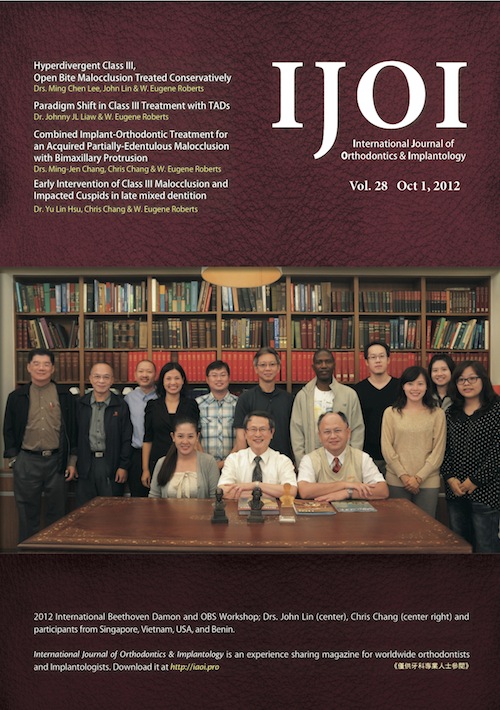IJOI Vol. 28 - updated

Hyperdivergent Class III, Open Bite Malocclusion Treated Conservatively
Lee MC, Lin JJ, Roberts WE
History and Etiology
A 17-year-9-month-old female presented for orthodontic consultation with chief complaints of anterior cross bite, open bite, and irregular dentition. She was previously advised by several orthodontists that surgery was the only viable option for correcting her malocclusion and facial asymmetry (Figs. 1-3). There were no contributing medical, dental or family histories. The etiology of the malocclusion was unknown, but it is probably genetic based on the nature of the malocclusion. The patient was treated to an optimal result as documented in Figures 4-6 without orthognathic surgery, extraoral anchorage or myofunctional therapy. No complex orthodontic appliances, such as rapid palatal expander (RPE) or lingual holding arch, were used. The cephalometric and panoramic radiographs documented the pre-treatment condition (Fig. 7) and the post-treatment results (Fig. 8). The cephalometric tracings before and after treatment are superimposed in Figure 9, and the summary of cephalometric measurements is provided in Table 1. (Int J Orthod Implantol 2012;28:4-18)
Paradigm Shift in Class III Treatment with TADs
Liaw JL, Roberts WE
Introduction
Mini-implant anchorage has been proven to be an effective therapeutic strategy in treating various kinds of malocclusions. It can be applied in many clinical orthodontic conditions successfully, including maximal retraction in protrusion cases, Class II correction, Class III correction, molar distalization in crowding cases, molar intrusion in molar elongation cases, deep bite correction, open bite correction, midline correction, and the correction of occlusal plane canting and posterior crossbite. (Int J Orthod Implantol 2012;28:22-36)
Combined Implant-Orthodontic Treatment for an Acquired Partially-Edentulous Malocclusion with Bimaxillary Protrusion
Chang MJ, Chang CH, Roberts WE
History and Etiology
A 31-years-old female presented for a full mouth evaluation (Fig. 1). Her chief concerns were bimaxillary protrusion, multiple caries, and edentulous spaces (Figs. 2, 3). There were no contributory medical problems. Clinical exam revealed a complex acquired malocclusion. There was a bimaxillary protrusion of the anterior segments, as well as edentulous spaces for missing maxillary right 1st molar, left 1st and 2nd premolar. Two residual root tips were noted in the maxillary right and left 1st molar areas. Deep caries were diagnosed in the mandibular right 1st premolar and 2nd molar. There were horizontally impacted mandibular third molars bilaterally (Fig. 2). The patient was treated to an acceptable result as documented photographically in Figs. 4-9. The cephalometric and panoramic radiographs document the pre-treatment condition (Fig. 7) and the post-treatment results (Fig. 8). The superimposed cephalometric tracings before and after treatment are shown in Fig. 9. (Int J Orthod Implantol 2012;28:38-64)
Early Intervention of Class III Malocclusion and Impacted Cuspids in late mixed dentition
Hsu YL, Chang CH, Roberts WE
History and Etiology
A 10 year and 2 month girl was referred by her family dentist for orthodontic consultation (Fig. 1). There was no contributory medical or dental history. Her chief complaint was a protrusive lower lip with the mouth closed. The relatively severe Class III developing malocclusion is documented in Figs. 2 and 3. The patient and her parents desired comprehensive orthodontic treatment to achieve an ideal profile and alignment of the entire dentition (Figs. 4-6). The pretreatment and posttreatment radiographic documentation is shown in Figs. 7 and 8, respectively. Fig. 9 illustrates the influence of the functional shift on facial esthetics, indicating that the patient is a good candidate for conservative management of this severe malocclusion in the late mixed dentition. (Int J Orthod Implantol 2012;28:66-79)
A Complex Maxillary Anterior Esthetic Case Study: Interdisciplinary Approach
Han T
In recent years, implant dentistry has been increasingly influenced by esthetic considerations. In addition to successful osseointegration, the implant restoration must be surrounded by a soft and hard tissue environment in harmony with the existing dentitions. Often, managing complex dental implant patient with demanding esthetics requires a multi-disciplinary approach involving orthodontics, periodontics, dental implantology, restorative dentistry, and dental occlusion. Furthermore, these disciplines must be employed in proper sequence to render a treatment, which is effective, practical and patient oriented. (Int J Orthod Implantol 2012;28:88-99)